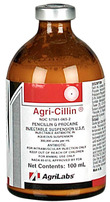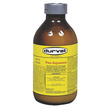Pronunciation
pen-ah-SIL-en - Pronunciation guide
Brand Names
- Agri-Cillin
- Ambi-Pen
- Amp-Equine
- Penicillin Injectable
Description
Penicillin is an antibiotic produced by a form of mold and used medically as a bactericidal to kill bacteria that causes diseases. Penicillin, in various forms, is one of the most commonly used antibiotics in veterinary medicine.
Different groups of penicillin are effective against different types of bacteria. Bacteria are often divided into two groups that have been catalogued because of their reaction to staining, a process developed by a Danish physician, Hans Christian Gram, that reveals differences in biochemical and structural properties. Simply put, when stained according to research custom, Gram-positive bacteria remain purple because they have a thick cell wall, and Gram-negative bacteria lose color because they have a thin cell wall.
Natural penicillins work against Streptococcus and other Gram-positive bacteria, such as Bacillus, Listeria, Stapylococcus, Enterococcus, and Clostridium.
Gram-negative bacteria, or proteobacteria, include Escherichia coli and Salmonella, among others.
Aminopenicillins, such as ampicillin, are effective against a broader spectrum of bacteria, including both Gram-positives and Gram-negatives. Extended spectrum penicillins, including ticarcillin, are active against a broad range of bacteria, including Pseudomonas, which are often resistant to other antibiotics.
Penicillins are easily and widely distributed throughout most organs and tissues of the body shortly after intra-muscular or intravenous administration. They are poorly absorbed when administered orally.
Usage
Penicillin in its various forms is used to treat a wide range of infections caused by numerous forms of bacteria. Given the number of forms of penicillin available and the variety of uses, consultation with a knowledgeable veterinarian is important at the earliest sign of infection or disease.
Dosage and Administration
| Penicillin | ||||
|---|---|---|---|---|
| Method | Dosage | Concentration | Period | Duration |
| Penicillin G, procaine | ||||
| Intramuscular injection1 | 6600-16000 IU/kg | 300000 IU/ml | Daily | Up to 7 days |
| Penicillin G, sodium or potassium | ||||
| Intravenous or Intramuscular1 injection | 20000 IU/kg | 5000000 IU/ml | Every 6 to 8 hours | Up to 7 days |
Notes:
|
||||
Many formulations are available. Consultation with a veterinarian is very important as to dosage and administration.
Side Effects
Side effects with penicillin usage are rare in animals.
Precautions
Penicillins should not be given to animals that have had an allergic reaction to any antibiotics in this group or to cephalosporin antibiotics because of the possibility of cross-reactivity. In all cases, the advice and prescription by a knowledgeable veterinarian is of great importance in determining what is best for each individual animal's case.
Several forms of penicillin are FDA approved for use with horses. Penicillins are prescription drugs and U.S. federal law restricts these drugs to use by or on the lawful written or oral order of a licensed veterinarian.
Interactions
Penicillin antibiotics should not be combined with bacteriostatic antibiotics, such as erythromycin, tetracycline, or neomycin.
Ampicillin may affect the activity of rifampin.
Large doses of certain penicillins have been associated with bleeding in humans. These penicillins should be closely monitored when used in horses, especially those receiving oral anticoagulants or heparin.
Overdose
Very high doses or overdoses of penicillin may cause neurological signs. Horses with decreased kidney funtion may be more likely to experience adverse effects.
Images
 Agri-Cillin Penicillin Injection
Agri-Cillin Penicillin Injection
 Pen-Aqueous Penicillin Injection
Pen-Aqueous Penicillin Injection
Literature
